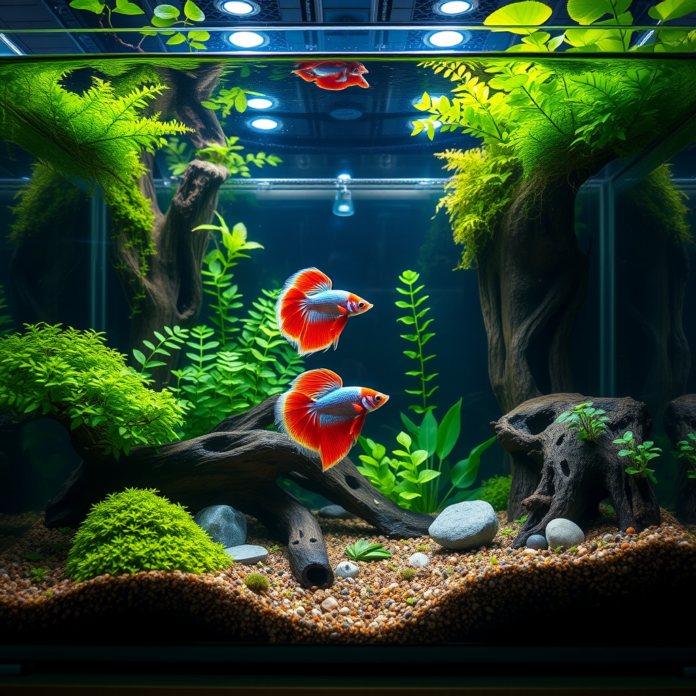Breeding Betta fish, also known as Siamese fighting fish, can be a rewarding and fascinating hobby. With their vibrant colors and dynamic personalities, Betta fish have captivated aquarists worldwide. This guide provides step-by-step instructions on successfully breeding Betta fish, from selecting the right breeding pairs to raising fry, along with potential challenges and solutions.
Table of Contents
- Selecting the Right Breeding Pairs
- Preparing the Breeding Tank
- Conditioning the Breeders
- Introducing the Pair
- Spawning Process
- Caring for the Eggs
- Raising Betta Fry
- Potential Challenges and Solutions
- Conclusion
Selecting the Right Breeding Pairs
1. Male and Female Selection
Choosing the right breeding pairs is crucial for successful Betta breeding. Here are the factors to consider:
- Age: Both male and female Betta fish should be mature, typically between 4-12 months old. Younger fish may not be ready to breed, and older fish may have lower fertility.
- Health: Select healthy, active fish with no visible signs of disease or deformity.
- Color and Fins: Choose fish with desirable traits you wish to pass on to the offspring. Vibrant colors and well-formed fins are often preferred.
- Temperament: While Bettas are naturally aggressive, choosing fish with manageable temperaments can reduce stress during breeding.
2. Sources for Breeding Pairs
- Reputable Breeders: Buying from reputable breeders ensures you get high-quality fish with known genetics.
- Pet Stores: Can be hit or miss. Ensure the fish are healthy and the store maintains good tank conditions.
Tip: Observe the fish for a while before purchasing. Healthy Bettas are active and responsive.
Preparing the Breeding Tank
1. Tank Size and Setup
A dedicated breeding tank is essential to provide a controlled environment for spawning.
- Tank Size: A 5-10 gallon tank is ideal.
- Water Level: Fill the tank with about 5 inches of water to make it easier for the male to tend to the bubble nest and eggs.
- Heater: Maintain a temperature of 80-82°F (27-28°C).
- Filter: Use a gentle filter or sponge filter to avoid disturbing the bubble nest.
- Cover: A lid or plastic wrap to keep the humidity high above the water surface, which helps the bubble nest stay intact.
2. Decorations and Hiding Spots
- Plants: Live or silk plants provide hiding spots and reduce stress for the female.
- Caves: Add a small cave or hiding spot for the female to retreat if the male becomes too aggressive.
- Bubble Nest Anchor: Include a floating object like a styrofoam cup or a large leaf for the male to build the bubble nest under.
3. Water Parameters
- pH Level: Slightly acidic to neutral (6.5-7.5).
- Water Hardness: Soft to moderately hard.
- Ammonia and Nitrite: 0 ppm (parts per million).
Visualization: Breeding Tank Setup
+----------------------------------------+
| [Floating Plants] |
| |
| [Bubble Nest Anchor] [Live Plants] |
| |
| [Cave] [Heater] |
| |
| [Hiding Spots] [Gentle Filter] |
+----------------------------------------+Conditioning the Breeders
1. Diet and Feeding
Conditioning your Betta fish with a high-protein diet prepares them for breeding.
- Diet: Feed live or frozen foods like bloodworms, brine shrimp, and daphnia. High-quality Betta pellets can also be included.
- Feeding Frequency: Feed small amounts 2-3 times a day for about two weeks before introducing the pair.
2. Monitoring Health
- Observation: Ensure both fish are healthy and active.
- Quarantine: If necessary, quarantine new fish to prevent the introduction of diseases.
Tip: Separate the male and female during conditioning but place their tanks close together so they can see each other. This helps stimulate breeding behavior.
Introducing the Pair
1. Gradual Introduction
- Acclimation: Float the female in a transparent container within the breeding tank to allow the male to see her without physical contact.
- Bubble Nest Building: The male will typically begin building a bubble nest upon seeing the female.
- Readiness Signs: The female will display vertical breeding bars, and the male’s fins will flare and dance around the tank.
2. Release and Observation
- Releasing the Female: After 24-48 hours, if both fish show signs of readiness, release the female into the tank.
- Supervision: Observe the interaction closely. Some chasing and nipping are normal, but excessive aggression requires intervention.
3. Intervening if Necessary
- Aggression: If the male becomes too aggressive, remove the female and try reintroducing after a few days.
Warning: Breeding Betta fish can be intense. Always have a plan to separate the fish if needed.
Spawning Process
1. Courtship and Spawning
- Courtship Display: The male will lead the female to the bubble nest and perform a courtship display.
- Egg Laying: The female releases eggs, which the male fertilizes and catches in his mouth to place in the bubble nest.
- Multiple Spawns: The process may repeat several times until the female has released all her eggs.
2. Post-Spawning Care
- Remove the Female: After spawning, remove the female to prevent the male from attacking her.
- Male’s Role: The male will tend to the eggs, keeping them in the bubble nest and protecting them.
3. Egg Development
- Hatching Time: Eggs typically hatch within 24-36 hours.
- Fry Development: Fry will remain in the bubble nest for a few more days until they become free-swimming.
Caring for the Eggs
1. Male’s Responsibility
- Tending the Nest: The male will keep the eggs in the nest, repair the bubble nest, and collect any fallen eggs.
- Minimal Disturbance: Avoid disturbing the tank to prevent the nest from collapsing.
2. Monitoring
- Check for Fungus: Monitor eggs for signs of fungal infection, which appear as white, fuzzy spots.
- Healthy Eggs: Healthy eggs are clear with visible embryos inside.
Raising Betta Fry
1. Removing the Male
- Timing: Once fry become free-swimming (3-4 days post-hatching), remove the male to prevent him from eating the fry.
2. Feeding Betta Fry
- Infusoria: Feed infusoria or commercial liquid fry food for the first few days.
- Microworms and Baby Brine Shrimp: Gradually introduce as the fry grow.
- Feeding Frequency: Feed small amounts 3-4 times a day to ensure consistent growth.
3. Water Quality and Maintenance
- Frequent Water Changes: Perform small, frequent water changes to maintain pristine water conditions.
- Gentle Filtration: Use a sponge filter to avoid sucking up the fry.
4. Monitoring Growth
- Growth Stages: Betta fry grow rapidly and will start showing color within a few weeks.
- Separating Fry: As fry grow, they may become territorial. Separate larger or more aggressive fry to prevent bullying.
Visualization: Betta Fry Growth
| Age | Food Types | Care Tips |
|---|---|---|
| 0-3 days | Infusoria | Keep tank stable and clean |
| 4-7 days | Infusoria, microworms | Small, frequent water changes |
| 1-4 weeks | Baby brine shrimp, microworms | Monitor for growth and health |
| 4+ weeks | Larger foods, Betta fry pellets | Separate aggressive individuals |
Potential Challenges and Solutions
1. Aggression Between Breeders
- Solution: Separate and reintroduce after a few days. Use a barrier if necessary.
2. Egg Fungus
- Solution: Remove infected eggs and improve water quality. Add anti-fungal treatments if necessary.
3. Male Eating Eggs
- Solution: Remove the male if he shows signs of eating the eggs. Use a breeding net to protect the eggs.
4. Slow Fry Growth
- Solution: Ensure adequate feeding with high-quality food. Maintain optimal water conditions.
5. Fry Mortality
- Solution: Monitor water quality closely and avoid overcrowding. Regularly separate fry based on size and aggression levels.
Conclusion
Breeding Betta fish is a fascinating and rewarding experience that requires patience, knowledge, and dedication. By following this step-by-step guide,
Disclaimer: This article is for informational purposes only. Always consult a professional aquarist or veterinarian for specific advice regarding your Betta fish.


